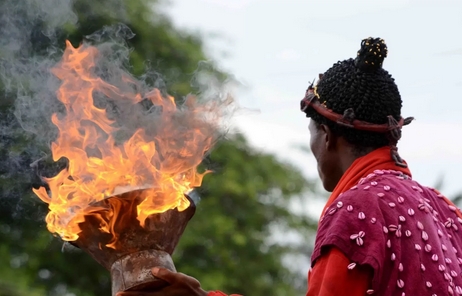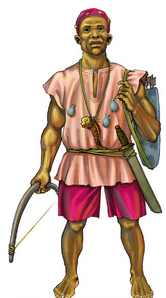
support@yorubalibrary.com
+2348073529208, 07038599574

The Yoruba people have a different tradition of festivals that celebrate her rich cultural heritage and spiritual beliefs. Among these, the Sango Festival stands out as one of the most significant. This festival is dedicated to Sango, the god of thunder and lightning, and is marked by elaborate ceremonies, rituals, and communal celebrations. In this article, we explore the importance of the Sango Festival, its origins, and the various activities that take place during this vibrant event.
Who is Sango?
Sango, also known as Shango, is one of the most powerful and revered deities in the Yoruba pantheon. He is the god of thunder, lightning, fire, and justice, and is often depicted wielding a double-headed axe. Sango is known for his fiery temper and immense power, as well as his role as a protector of the people. His worshippers seek his blessings for courage, protection, and prosperity.
Historical Origins of the Sango Festival
The Sango Festival has ancient roots, dating back to the time when Sango was a mortal king of the Oyo Empire. Sango was later deified after his mysterious death, and his legacy has been celebrated through the festival ever since. The festival is particularly significant in Oyo, where Sango was a historical ruler, but it is also observed in various Yoruba communities both in Nigeria and the diaspora.
Rituals and Celebrations
1. Sacrifices and Offerings
The festival begins with rituals and sacrifices to honor Sango and seek his blessings. These offerings often include ram, cocks, yams, and other items that are significant in Yoruba culture. The sacrifices are conducted by the priests and priestesses of Sango, who perform chants and invocations to call upon the deity’s spirit.
2. Drumming and Dancing
Traditional drumming and dancing are central to the Sango Festival. The powerful beats of the drums and the energetic dances are believed to invoke Sango’s presence. Dancers, often adorned in red and white attire (colors associated with Sango), perform vigorous and acrobatic moves, reflecting the fiery nature of the deity.
3. Masquerades (Egungun)
Masquerades, known as Egungun, play a significant role in the festival. These masked performers represent ancestral spirits and are believed to channel the powers of Sango. The Egungun parade through the streets, engaging in lively dances and performances that captivate the audience and add a mystical element to the celebrations.
4. Fire and Lightning Displays
Given Sango’s association with fire and lightning, the festival features displays that symbolize these elements. Fireworks, bonfires, and lightning-like effects are often used to dramatize the power and presence of Sango. These displays are a highlight of the festival and are intended to awe and inspire the participants.
5. Community Feasting
The Sango Festival is also a time for communal feasting. Large quantities of food and drink are prepared and shared among the community members. This act of sharing reinforces social bonds and reflects the abundance and blessings attributed to Sango. It is a time for families and friends to come together in celebration and gratitude.
Cultural and Spiritual Significance
The Sango Festival is more than just a celebration; it is a profound expression of Yoruba spirituality and cultural identity. It serves as a reminder of the power and justice that Sango represents and reinforces the community’s connection to their ancestral roots. The festival also provides an opportunity for participants to seek Sango’s protection and blessings, ensuring the well-being and prosperity of the community.
Modern Relevance
In contemporary times, the Sango Festival continues to be a vibrant and relevant cultural event. It attracts visitors from around the world, including members of the Yoruba diaspora who seek to reconnect with their heritage. The festival also serves as a platform for promoting Yoruba culture and traditions, preserving them for future generations.
Conclusion
The Sango Festival is a powerful and dynamic celebration that holds immense significance in Yoruba culture. Through rituals, sacrifices, drumming, dancing, and communal feasting, the festival honors Sango, the god of thunder and lightning, and reinforces the cultural and spiritual bonds of the Yoruba people. It remains a testament to the enduring legacy of Sango and the rich cultural heritage of the Yoruba community.

Learn about the Yoruba concept of Ìwà Pẹ̀lẹ́ (good…

Learn special praises for Divine Being and Creator…